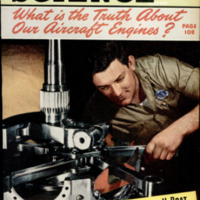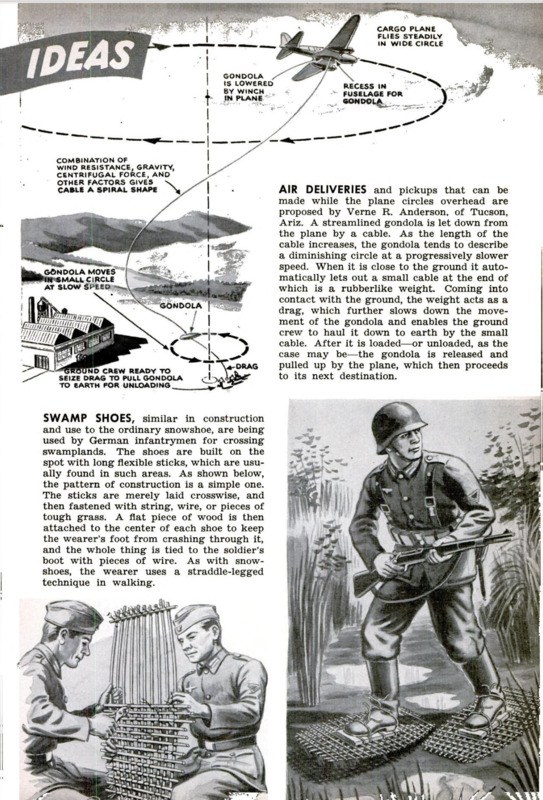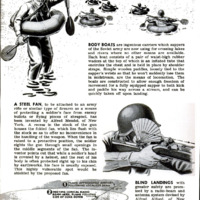War Ideas
Item
-
Title (Dublin Core)
-
War Ideas
-
Article Title and/or Image Caption (Dublin Core)
-
War Ideas
-
extracted text (Extract Text)
-
BODY BOATS are ingenious carriers which sappers
of the Soviet army are now using for crossing lakes
and rivers where no other means are available.
Each boat consists of a pair of waist-high rubber
waders at the top of which is an inflated tube that
encircles the chest and is held in place by shoulder
straps. Simple wooden paddles, loosely tied to the
sapper’s wrists so that he won't suddenly lose them
in midstream, are the means of locomotion. The
boats are constructed to allow enough freedom of
movement for a fully equipped sapper to both kick
and paddle his way across a stream, and can be
quickly taken off upon landing.
A STEEL FAN, to be attached to an army
rifle or similar type of firearm as a means
of protecting a soldier's face from enemy
bullets or flying pieces of shrapnel, has
been invented by Alfred Mendel, of New
York. A recess in the stock of the gun
houses the folded fan, which lies flush with
the stock so as to offer no inconvenience in
the handling of the weapon. When the fan is
raised to a protective position, the soldier
sights the gun through small openings in
the middle segments of the fan. The in-
ventor points out that while a soldier's head
is covered by a helmet, and the rest of his
body is often protected right up to his chin
by earthworks, his face is usually exposed.
This highly vulnerable spot would be
shielded by the proposed fan.
BLIND LANDINGS with
greater safety are prom-
ised by a radio-beam and
antenna system devised by
Alfred Alford, of New
York. A radiation is
spread out in the form of
a cone, the apex of which
is at one side of the runway. A beam
guides the pilot to a position directly over
the runway. When the plane reaches the
cone, it descends in a gentle hyperbolic
curve, its wheels finally touching the
the ground at the curve's lowest point.
AIR DELIVERIES and pickups that can be
made while the plane circles overhead are
proposed by Verne R. Anderson, of Tucson,
Ariz. A streamlined gondola is let down from
the plane by a cable. As the length of the
cable increases, the gondola tends to describe
a diminishing circle at a progressively slower
speed. When it is close to the ground it auto-
matically lets out a small cable at the end of
which is a rubberlike weight. Coming into
contact with the ground, the weight acts as a
drag, which further slows down the move-
ment of the gondola and enables the ground
crew to haul it down to earth by the small
cable. After it is loaded—or unloaded, as the
case may be—the gondola is released and
pulled up by the plane, which then proceeds
to its next destination.
SWAMP SHOES, similar in construction
and use to the ordinary snowshoe, are being
used by German infantrymen for crossing
swamplands. The shoes are built on the
spot with long flexible sticks, which are usu-
ally found in such areas. As shown below,
the pattern of construction is a simple one.
The sticks are merely laid crosswise, and
then fastened with string, wire, or pieces of
tough grass. A flat piece of wood is then
attached to the center of each shoe to keep
the wearer's foot from crashing through it,
and the whole thing is tied to the soldier's
boot with pieces of wire. As with snow-
shoes, the wearer uses a straddle-legged
technique in walking.
-
Language (Dublin Core)
-
eng
-
Date Issued (Dublin Core)
-
1943-06
-
pages (Bibliographic Ontology)
-
106-107
-
Rights (Dublin Core)
-
Public Domain (Google digitized)
-
Archived by (Dublin Core)
-
Matteo Ridolfi
-
Alberto Bordignon (Supervisor)
 Popular Science Monthly, v. 142, n. 6, 1943
Popular Science Monthly, v. 142, n. 6, 1943




